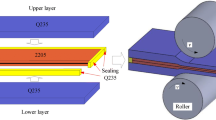Abstract
In order to obtain large-area titanium-steel cladding plate by vacuum rolling, the manufacturing process was discussed with the Hypermesh/LS-DYNA simulation software. The result showed that the reduction rates of each rolling pass were 20, 25 and 33%, respectively. And the total rate was 60%. Moreover, the vacuum rolling process mainly included the following steps: welding preparation, drilling vacuum holes, composite and assembly, vacuum extraction, accumulative seal welding, preheating and rolling. The final size of the cladding plate was 1650 × 12000 × (4 + 40) mm. It could be found that the vacuum rolling interface of the titanium-steel cladding plate was mainly divided into four parts: steel layer (I), decarburized layer (II), bonding layer (III) and titanium layer (IV). Acicular widmanstatten structure of β-titanium was formed in zone IV, which might reduce the impact toughness of joint. The microhardness test results showed that the hardness near the interface was relatively high. Macroscopically, the average shear strength (297 MPa) and the average tensile strength (590 MPa) were both much higher than the standard. However, the brittle fracture mode of shear specimens might decrease the joint property of vacuum rolling cladding plate.











Similar content being viewed by others
REFERENCES
Findik, F., Recent developments in explosive welding, Mater. Design, 2011, vol. 32, no. 3, pp. 1081–1093.
Shi, C.G., The Lower Bound Theorem and Double Vertical Method of Explosive Welding, Beijing: Metallurgical Industry, 2015, 1st ed.
Zheng, Y.M., The Principle and Application of Explosive Welding and Metallic Composite, Wuhan: Central South Univ., 2007, 1st ed.
Xie, M.X., Zhang, L.J., Zhang, G.F., et al., Microstructure and mechanical properties of CP-TiX65 bimetallic sheets fabricated by explosive welding and hot rolling, Mater. Design, 2015, vol. 84, pp. 181–197.
Zeng, S.W., Zhao, A.M., Jiang, H.T., et al., High-temperature deformation behavior of titanium clad steel plate, Rare Met., 2015, vol. 34, no. 11, pp. 764–769.
Yang, X., Shi, C.G., Ge, Y.H., et al., Comparison of microstructure and mechanical properties of titanium/steel composite plates by two manufacturing processes, J. Iron. Steel. Res. Int., 2018, vol. 25, no. 3, pp. 347–356.
Manikandan, P., Hokamoto, K., Deribas, A.A., Raghukandan, K., and Tomoshige, R., Explosive welding of titanium/stainless steel by controlling energetic conditions, Mater. Trans., 2006, vol. 47, no. 8, pp. 2049–2055.
Shi, C.G., Wang, Y., and Zhao, L.S., Detonation mechanism in double vertical explosive welding of stainless steel/steel, J. Iron. Steel. Res. Int., 2015, vol. 22, no. 10, pp. 949–953.
Luo, Z.A., Wang, G.L., and Xie, G.M., Interfacial microstructure and properties of a vacuum hot roll-bonded titanium-stainless steel clad plate with a niobium interlayer, Arch. Civ. Mech. Eng., 2013, vol. 26, no. 6, pp. 754–760.
Wang, G.L., Luo, Z.A., and Xie, G.M., Effect of first pass rolling on microstructure and properties of rolling clad steel plate, Northeast Univ., 2012, vol. 33, no. 10, pp. 1431–1435.
Yang, D.H., Luo, Z.A., Xie, G.M., Wang, M.K., and Misra, R.D.K., Effect of vacuum level on microstructure and mechanical properties of titanium-steel vacuum roll clad plates, J. Iron. Steel. Res. Int., 2018, vol. 25, no. 1, pp. 72–80.
Zheng, L.W., Liang, W., Zhao, Z.L., et al., Effect of homogenizing annealing treatment on hot-rolled microstructure and mechanical properties of AZ91 magnesium alloy, Rare Metal. Mat. Eng., 2015, vol. 45, no. 5, pp. 1296–1300.
Luo, Z.A., Xie, G.M., Wang, G.D., et al., Interface of heavy gauge plate by vacuum cladding rolling, Steel. Res. Int., 2010, vol. 81, no. 9, pp. 51–53.
Wang, G.L., Luo, Z.A., and Xie, G.M., Effect of heating temperature on the bonding property of the titanium/stainless steel plate by hot-rolling bonding, Rare Metal. Mat. Eng., 2013, vol. 42, no. 2, pp. 387–391.
Wang, C., Research on sandwich rolling charged on finite elements by ANSYS, Dissertation, Wuhan Univ. Sci. Technol., 2006.
He, Q.S., Finite-element simulation of plan view pattern control during plate rolling process, Dissertation, Wuhan Univ. Technol., 2009.
Byon, S.M., Doo-Hyun, N.A., and Lee, Y.S., Flow stress equation in range of intermediate strain rates and high temperatures to predict roll force in four-pass continuous rod rolling, T. Nonferrous Metal. Soc., 2013, vol. 23, no. 3, pp. 742–748.
Luo, Z.A., Xie, G.M., Wang, G.L., and Wang, G.D., Effect of interfacial microstructure on mechanical properties of vacuum rolling clad pure titanium/high strength low alloy steel, Chin. J. Mater. Res., 2013, vol. 27, no. 6, pp. 569–575.
Wu, H.J., Rong, Y., and Li, X.D., Rolling process of wide titanium sheet ply, Chin. J. Nonferrous Met., 2010, vol. 20, no. S1, pp. 807–810.
Shangguan, X.F., Yao, Y.H., and Jin, Y.H., Engineering Material, Beijing: Chemical Industry, 2013, 1st ed.
Qin, L.Y., Research on key technique of laser deposition repair titanium alloy, Dissertation, Shenyang Univ. Technol., 2014.
Cai, G., Lei, M., Wan, M.P., Sun, J., and Liu, X., Continuous cooling transformation diagram of BT25 titanium alloy, Rare Metal. Mat. Eng., 2016, vol. 45, no. 10, pp. 2578–2582.
State Key Laboratory of Rolling & Automation, Research Report no. 7, Beijing: Metallurgical Industry, 2014, 1st ed.
Li, X.J., Ma, H.B., and Shen, Z.W., Research on explosive welding of aluminum alloy to steel with dovetail grooves, Mater. Design, 2015, vol. 87, pp. 815–824.
ACKNOWLEDGMENTS
This work was supported by the National Natural Science Foundation of China (grant no. 51541112).
ADDITIONAL INFORMATION
ORCID ID of the correspondence author: https://orcid.org/0000-0002-3413-4563.
Author information
Authors and Affiliations
Corresponding author
Additional information
The article is published in the original.
About this article
Cite this article
Chang-gen Shi, Yang, X., Shi, Hs. et al. Manufacturing Process and Interface Properties of Vacuum Rolling Large-Area Titanium-Steel Cladding Plate. Russ. J. Non-ferrous Metals 60, 152–161 (2019). https://doi.org/10.3103/S1067821219020032
Received:
Revised:
Accepted:
Published:
Issue Date:
DOI: https://doi.org/10.3103/S1067821219020032




